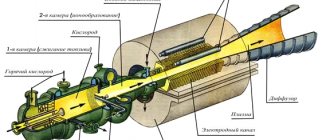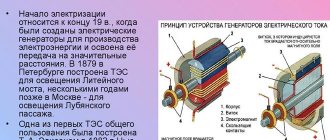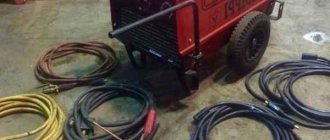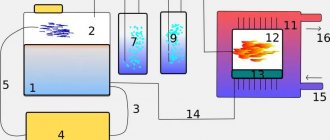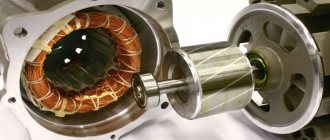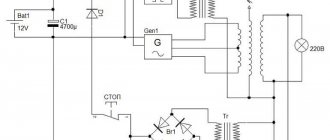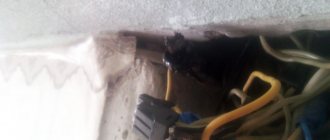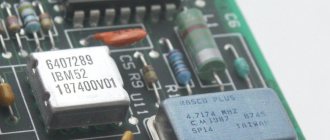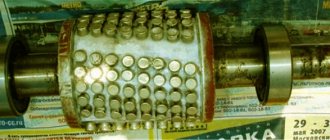In professional activities and at home, inverter generators are used for welding work. Many people have such devices today. In this article we will look at what an inverter generator means.
Essentially, it is an electronic unit that converts direct current into alternating current. It is not difficult to understand the structure of an inverter generator: it consists of a stator, with windings and a rotor located on it. The latter is equipped with several poles with electric or permanent magnets. Due to the rotation of the rotor, a magnetic field is created that penetrates the stator winding. As a result, a voltage generated by the generator appears in the stator.
Diagram of a classic electric generator without inverter technology Source club.dns-shop.ru
How does an inverter generator work, what is the difference with a regular one?
The principle of its operation, in contrast to the standard one, is that during the processing of fuel (gasoline or diesel), high-frequency alternating current is generated, which is immediately converted into direct current and transferred to the battery, where it is accumulated.
Compared to an inverter unit, which has a low noise level during operation, the standard unit is very noisy and emits exhaust gas.
A portable generator is a mobile diesel or gasoline device, some of the models are hybrids. Their engine can operate on several types of fuel, for example: a mixture of gasoline and propane.
Welding power station
In the case where you plan to purchase a generator and a welding machine, it makes sense to consider the possibility of purchasing a welding power station that combines these two devices. It is logical to expect that the cost of purchasing one multifunctional device will be less than the cost of two separate ones.
Figure 7. BlueWeld Motoweld brand welding stations are popular.
A welding power station is an autonomous electric generator combined with an electric arc welding machine. The power plant is designed to perform welding work in field conditions, as well as provide consumers with electrical energy. There are various modifications of such stations:
- combining a generator with a step-down transformer to perform manual arc welding with alternating current using a stick electrode;
- station with a rectifier providing DC welding;
- station with a built-in inverter welding machine.
An AC welding machine is one of the most budget-friendly options, however, welding of critical metal structures, as a rule, is not carried out with alternating current. DC welding has great capabilities; the weld seam when used is of better quality.
The best is the combination of a generator with an inverter welding machine, but this option is also the most expensive; in addition to them, there are both gasoline and diesel options.
Voltage characteristics of inverter generator
Power parameter - 0.8 - 0.9 kW; fuel - gasoline; The output potential is single-phase, 220 V. The voltage waveform is sinusoidal with minor distortion. The quality of the sine wave is affected by the level of harmonic curvature, the permissible value is 8%.
The difference between conventional and inverter generators Source planeta-instrument.com.ua
Operating principle of an inverter gas generator
Any inverter-type device is built on the use of a gasoline engine. The motor transmits torque to the rotor, which leads to the appearance of an electromagnetic field, which subsequently becomes an alternating voltage. By means of a double output energy converter, the current required to power consumers is obtained. It is these features that allow us to talk about the differences between an inverter generator and a conventional device. After transformation from direct voltage to alternating voltage, it is possible to obtain a current with the best technical performance.
What to choose: a classic or inverter generator?
Living in a country house in the conditions of Russian reality is associated with certain difficulties. This mainly has to do with power outages. The problem is solved by purchasing an independent source of electricity - a generator.
The number of models manufactured by manufacturers on the market is great. In this article we will look at some features that will help home owners in purchasing a generator set. Sequence of steps:
- First, determine the total power consumption for the entire house.
For each owner, this figure will be purely individual. On average, one cottage requires about 10-15 kW of electricity. For a summer house, 2-5 kW is enough.
- Select generator type.
The units are: regular diesel or gasoline, inverter.
Diesel generator AMPEROS LDG 3600 CL Source gaspowersystems.com
Standard generator
The electric current it produces is crude, not entirely pure. Its parameter is very different from the value indicated in the passports of household appliance manufacturers. For this reason, it is not advisable to use conventional generators to power high-precision electronics. However, such units have a number of advantages:
- Wide selection of power models.
Manufacturers produce from the smallest of 1 kW to large powers of 9-10 kW. There are industrial designs from 20 to 100 kW. However, they are not suitable for domestic use due to excess power.
- Easy to use.
The generator is easy to operate if you follow the operating conditions established by the manufacturer.
- The price is cheaper than inverter models.
Due to their availability, stationary generators are in demand on the market today.
Is it possible to connect a welding machine to a gas generator?
Welding machines are used in many areas of human activity. They help solve problems in everyday life in a country house, in small manufacturing enterprises, in auto repair shops, and in large industrial facilities.
Welding is especially in demand on construction sites, where until recently heavy transformer welding machines were used. They are large in size, such a unit must be transported by road.
Transformer welding is problematic to move around the construction site.
Welding process
Generator types
Manufacturers make generators for various purposes. The best option is to choose an inverter-type gasoline generator, especially for welding machines. Preferably from the same manufacturer as the welding machine.
A gasoline generator using inverters produces a very stable high-frequency voltage and current. This ensures high quality welding and a long service life of the welding machine.
Generators are divided into three types:
- Industrial models of gas generators are used in metal structures manufacturing plants that operate full time or around the clock. They have high welding currents, the connecting seams are very high quality. For such inverters, you need to choose a gasoline generator capable of delivering currents of 250-500 A.
Model of industrial inverter gas generator
- Professional models of medium power are used by housing and communal services workers, construction workers, and emergency services employees.
Professional inverter gas generator
- Low-power household ones, for short-term work, require generators with an output current of 130–200 A.
Depending on the tasks performed and operating conditions, it is necessary to select a generator taking into account the following factors:
- weight;
- dimensions;
- transportation methods;
- number of generator options;
- the length of the wires from the generator to the welding inverter (with a length of more than 15 m, the voltage and power begin to decrease);
- what type of generator, three or single phase output voltage;
- Of great importance in terms of safety is the option to reduce the voltage in idle mode.
Small-sized, lightweight, portable, gasoline inverter generators are in great demand among household consumers. The forum of the portal about welding equipment on the Internet reveals questions about which country and manufacturer of generators are better.
. Generator welding
From the above information it is clear that for domestic short-term work it is enough to take a gasoline inverter generator slightly higher than the calculated average power consumption of the inverter welding machine.
By setting the welding current on the panel to medium or slightly higher power, you can carry out high-quality welding work with electrodes up to 3 mm Ø. This will save money on purchasing a generator.
In other cases, it is better to choose an industrial or professional inverter gas generator.
When choosing generators of this group, the power is calculated based on the maximum power consumed by the welding machine plus 30–40%.
Only such conditions will ensure high-quality welding and long-term operation of the equipment.
- Registration: 04/10/08 Messages: 9 Thanks: 3 Good time everyone! I bought a Greenfield 3600 gas generator for my dacha and garage. At the dacha on weekends, the mains voltage is 150. Please tell me what kind of welding inverter I can buy so that the generator does not burn out and the welding works in normal mode? Budget 9000-11000 rub.
- Predatory_Mouse
I recommend reading here:
Video description
Weaknesses, disadvantages of inverter generators.
In addition to the advantages, there are disadvantages:
- There is a limit on the permissible load.
Conventional devices cannot be used if the total load is less than 25%, but it is also undesirable to exceed more than 75%.
- With low power of connected devices, fuel consumption is almost the same as when operating at full capacity.
- Noisy generator operation.
- Emission of exhaust gases.
- For the room where the generator is installed, it is necessary to remove exhaust gas particles through the laying of a separate air line.
If the unit runs on gasoline, it is not recommended that the engine be operated at constant speed. This condition greatly affects the quality of the generated electricity. Frequent breakdowns of installations occur precisely when this recommendation is not followed.
Inverter generator
These units are suitable for providing electricity to complex stationary equipment that requires a stable voltage: computer devices, heating boilers, various controllers, electronics.
Inverter generators have a number of advantages:
- Characterized by stable electrical parameters.
- Load level affects fuel consumption.
In case of partial load, when operating at low speeds, a little gasoline is consumed.
- Weight and dimensions are small.
You can take such a unit with you to any event held geographically far from civilization. For example: hunting, fishing, hiking.
- Low noise level during operation.
In the event of an emergency power outage in a residential building that has many household appliances, it is best to connect an inverter generator. Repairing and purchasing new equipment that burned out during a sudden power surge will be slightly more expensive than the price of the generating set.
Disadvantages of the inverter:
- High price.
In stores it costs approximately 1.5 - 2 times higher than a stationary generator of the same power.
- It is not possible to repair individual parts.
If any element fails, you need to purchase a new generator.
- The maximum power of the inverter unit is 6 kW.
It turns out that if there is a need for a constant source of electricity for buildings, construction sites, or there is a need to organize emergency lighting, then it makes sense to buy a standard generator.
When operating at full power, such a unit will last a long time. In this case, no repairs will be required, and additional costs during the period of its operation are also unlikely. If you use only high-quality fuel and carry out timely maintenance and oil changes, the service life of the generator will significantly increase.
Maintenance and installation of Elitech generators Source elitech-tools.ru
If it is necessary to solve two problems at once: in case of emergency and as a constant power source, then it is optimal to use a combined solution. With this option, standard and inverter generators operate simultaneously.
How to buy a gasoline generator correctly
When choosing a generator, it is important to correctly determine the power of the unit you need. Conventionally, they can be divided according to power into three groups:
- up to 5 kilowatts. Structurally, it is made in the form of a small suitcase, convenient for carrying. Such a generator will provide power to household and lighting devices for a short time at the dacha, during repair and construction work, it can be taken fishing and even on a hike;
- up to 10 kilowatts. Such units are much larger than the previous group and are mounted on wheels. They are used in facilities with average power consumption;
- up to 20 kilowatts. Such a unit is capable of providing a large facility.
The type of load for which the selected electric generator is intended is of great importance. If this is lighting, household appliances and power tools, then you can use a synchronous type generator, if high-tech equipment (computers, computing or video systems, etc.) then an inverter type generator.
Simple Gasoline Generator.
The most popular gas generators are: GMGen, Fubag, Prorab, Huter, Honda.
Inverter generator device
The design of the unit, combined into a single housing, includes:
- internal combustion electric motor;
- a generator that produces voltage;
- an inverter unit that converts alternating current into direct current;
- terminals for connecting output circuits;
- control and monitoring unit for technological cycles.
To connect devices, a general industrial output of electrical energy is used through 3 power contacts of a standard socket designed for alternating current 220 V.
Generators are classified according to various parameters.
By design features
Closed. They can work in dusty rooms or outdoors in any weather.
Inverter generator running on gasoline Source yandex.ru
Open. These are usually high-power models that can withstand heavy loads and require good ventilation.
By power
- Portable (1-3 kW).
They weigh up to 8 kg and come in the form of a small suitcase.
- Medium (up to 6 kW).
They weigh up to 100 kg and are made as a monoblock.
- Heavy (up to 8 kW).
They weigh more than 100 kg, these are professional devices, they work under high load conditions.
By launch method
Manual: to turn it on, you need to pull the cable, usually these are cheap models.
Automatic: started by a starter, equipped with powerful units.
By type of output signal (sine wave)
Clean. They are used to supply electricity to high-precision equipment that are very sensitive to power surges: computers, audio systems, medical equipment.
Modified. They are used to power household appliances that are not so demanding on the parameters of the electrical network: refrigerators, televisions, microwaves.
Operating principle and current quality
Before moving on to considering the operating features of the inverter device, it is worth mentioning its main advantage - the ideal quality of the current.
How is it achieved? The alternator is responsible for converting mechanical energy (formed after fuel combustion) into electricity and, accordingly, its quality in power plants. Generators use one of two types of alternators:
- Classical
- Inverter
The quality of the current in a classic alternator depends on many factors, ranging from the type of load to the characteristics of the fuel. At the same time, the engine operates at maximum and even in idle mode, fuel continues to be consumed, and functional parts are subject to wear.
As for the inverter alternator, here the alternating current undergoes some transformations - first into direct current, then passes it through a filter capacitor and only then is inverted back (hence the “inverter”). What is the benefit of such a complex conversion circuit? It allows the electrical signal to achieve high frequency and voltage accuracy.
The use of high-quality current makes it safe to connect any sensitive electronics. This is the reason for choosing an inverter generator for home and long trips.
Welding inverter generator control
The operating principle of such a unit is based on a 2-fold transformation of the properties of electric current. The generator must have the following functions:
- Fast start.
The arc is ignited at an accelerated pace. Thanks to this, it will be easy for a beginner to obtain a stable flame by slightly increasing the operating current.
- Automatic sticking.
The unit is protected from breakdown in the event of a short circuit during welding: the voltage drops to zero, the current increases to infinity. In such a situation, the inverter circuit automatically turns off the device.
- Arc force.
The current increases for a short moment when the voltage drops to 20 - 25 V. The function is needed for welding thick sheets of steel.
- Voltage stabilization.
It is important when working in conditions of unstable power grids, especially important in rural areas, as well as when connected to an electric generator.
- Temperature regime.
There is a need for use at different air temperatures. Good models allow the unit to operate within the range from - 20 to + 40C.
The principle of operation of the 220 V device is that the welding operating mode (SW) alternates with periodic shutdowns. With a value of PV = 0.6, welding work can be performed continuously for 4 minutes. Then the unit will turn off after approximately 4/0.6 = 6.67 minutes. These parameters are indicated by the manufacturer in the device passport.
Conclusion
- To organize backup (emergency) lighting, power supply to construction sites or buildings that do not have complex electronic equipment, it is better to purchase a generator assembled according to the classical scheme. Or, as they call it, ordinary. In such situations, no one places increased demands on the quality of voltage, and given the lower cost of such power stations, they are the best option.
- But to connect to the electrical circuit of a residential building, literally crammed with various household appliances, it is better to opt for an inverter-type installation. The advantages of such generators are indicated, so it makes no sense to comment on this recommendation, in principle. The main thing is to make accurate power calculations.
Useful advice If the country house is large, and it is necessary to provide electricity not only to it, but also to the garden plot and outbuildings, then it makes sense to combine them. That is, do the routing of lines. Some are connected to a conventional generator, others to an inverter. With proper design of the power supply scheme, you can optimize costs and obtain stable voltage in those circuits where it is necessary, depending on the specific load.
How to choose
- First, let's start with the fact that in the “inverter generator” category there are no models with a power of more than 6 kW. Therefore, before purchasing this device, you need to accurately calculate the power consumption of lighting and household appliances in the house.
- Secondly, if a generator is purchased for regular use, then it is better to give preference to classic models. But, as mentioned above, the load on the electrical network and the power of the equipment will have to be brought to equal levels.
- Thirdly, if you need a small mobile generating unit that will supply electricity not to the entire house, but to some part of it or a certain number of current-consuming appliances, then the inverter type is the best option for this.
